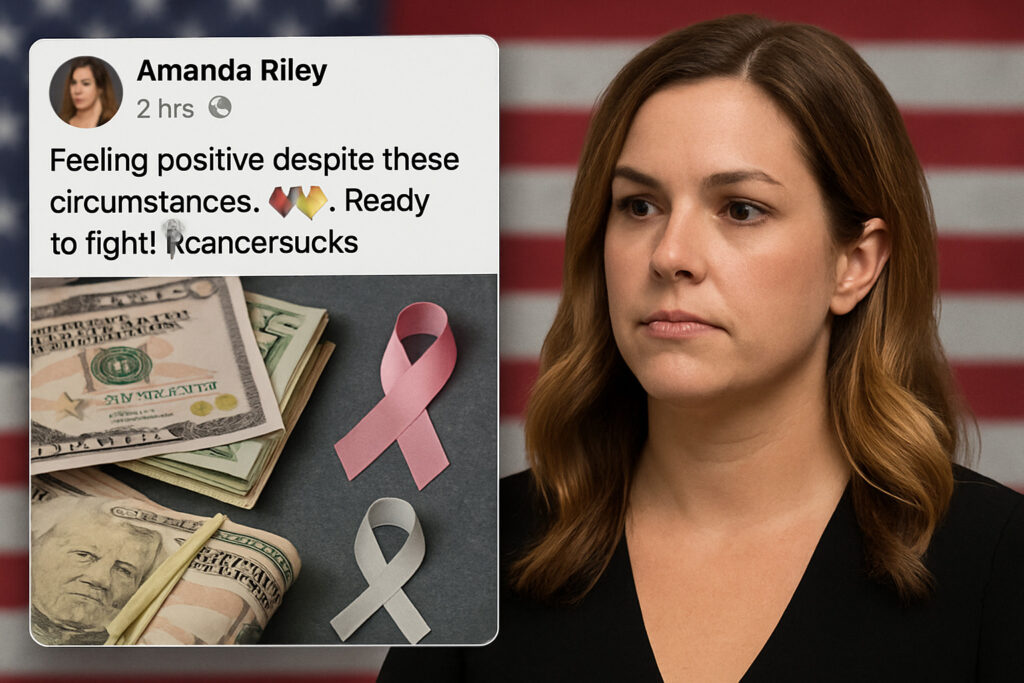The Shocking Truth Behind Scamanda
Scamanda refers to the infamous case of Amanda Riley, a California woman who faked having cancer for nearly eight years (2012-2020) and fraudulently collected over $105,000 from 349 donors through an elaborate online deception.
| Scamanda Quick Facts | |
|---|---|
| Real Name | Amanda Riley |
| Fraud Period | 2012-2020 (nearly 8 years) |
| False Claim | Stage 3 Hodgkin’s lymphoma |
| Money Stolen | $105,513 (wire fraud) + est. $80,000 (cash/gifts) |
| Sentence | 5 years in federal prison |
| Current Status | In residential re-entry center until December 2025 |
In May 2012, shortly after giving birth to her first child, Amanda Riley claimed she had received devastating news: a diagnosis of stage 3 blood cancer. The young wife, mother, and devout Christian from Southern California quickly started a blog titled “Lymphoma Can Suck It” to document her supposed cancer journey. Through heart-wrenching posts, staged hospital photos, and falsified medical documents, Riley built a compelling narrative that captivated thousands of followers.
What made the Scamanda case so shocking wasn’t just the brazen nature of the fraud, but how effectively Riley maintained the deception. She shaved her head, posed with IV lines, faked hospital visits, and even claimed to undergo chemotherapy while pregnant with her second child—explaining that pregnancy was “reversing the disease” when questioned about the medical impossibility.
The truth? Amanda Riley never had cancer. Not even once.
The elaborate hoax began solveing when a childhood friend noticed inconsistencies—like Riley going swimming shortly after claiming to have fluid drained from her brain. An anonymous tip to investigative producer Nancy Mosciatello triggered a five-year investigation that would eventually expose one of the most notorious medical fraud cases in recent history.

The Rise and Fall of Scamanda: Amanda Riley’s Eight-Year Hoax
The Scamanda story stands as one of the most intricate medical frauds of our time. For nearly eight years, Amanda Riley maintained an elaborate fiction about battling stage-3 Hodgkin’s lymphoma. Her blog—perfectly titled “Lymphoma Can Suck It”—became the heartbreaking digital diary that pulled readers into her supposed cancer journey.
What made Riley’s deception so effective wasn’t just her storytelling, but how perfectly she fit the role of someone deserving compassion. As a young mother and active megachurch member, she embodied the ideal sympathetic character—a faithful Christian fighting a terrible disease while raising small children.
“Amanda had this magnetic presence in her church community,” recalled a former friend interviewed for the Scamanda docuseries. “People naturally wanted to help her.” This natural charisma, paired with her seemingly transparent documentation of cancer treatments through regular social media updates, created a narrative few thought to question.
Who Is Amanda Riley and How Did “Scamanda” Begin?
Before becoming infamous as “Scamanda,” Amanda Riley led what appeared to be a normal life. A Southern California native with roots at San Jose State University, she had settled into married life with her husband Cory and became deeply involved in their local megachurch community.
The fraud began in May 2012, just days after giving birth to her first child. Riley claimed doctors had delivered devastating news: stage 3 Hodgkin’s lymphoma. This dramatic contrast—new motherhood colliding with a cancer diagnosis—created an instantly compelling story that drew immediate sympathy and support.
Perhaps the boldest chapter came in 2013 when she announced her second pregnancy while supposedly undergoing aggressive chemotherapy. When people questioned how this was medically possible, Riley claimed her doctors were amazed that pregnancy was not only safe in her case but might actually be “reversing the disease.”
The Blog & Social Media Engine Behind Scamanda
The foundation of Riley’s deception was surprisingly straightforward yet effective. Her WordPress blog “Lymphoma Can Suck It” served as command central for her fiction, featuring regular updates about treatments, setbacks, and occasional “victories” in her cancer battle.
Her social media presence across Instagram and Facebook amplified this narrative with intimate glimpses into her “cancer journey.” She shared convincing photos of hospital visits, IV lines inserted in her arm, her dramatically shaved head, and pill containers she claimed contained her treatment medications.
Anatomy of the Scam: How Amanda Riley Faked Cancer and Collected $105K+
Behind the heartbreaking story that captivated hundreds of supporters lay a carefully orchestrated deception. Scamanda’s fraud wasn’t just convincing—it was carefully planned.
Riley created a paper trail of “evidence” by forging doctor’s letters and manipulating her FollowMyHealth patient portal. When she needed “proof” of treatment, she’d employ a simple yet effective tactic: walking into different emergency rooms and pretending to faint.
“She would deliberately cause herself to collapse in hospital lobbies,” one investigator explained. “Once admitted, she’d receive IV fluids for dehydration, snap photos with the IV in her arm, and share them as ‘another chemo day’ on social media.”
The staging didn’t stop there. Riley purchased medical supplies like syringes and IV tubing to create convincing photos. She willingly shaved her head and maintained a thin appearance to reinforce her fabricated narrative.

The financial impact was substantial. Court records confirmed that Scamanda defrauded at least 349 donors of $105,513 through traceable online transactions. However, investigators believe an additional $80,000 flowed through less traceable channels—cash, personal checks, gift cards, and donated services—bringing the estimated total closer to $185,000.
| Real Cancer Treatment Signs | Amanda Riley’s Faked Signs |
|---|---|
| Consistent treatment at specific hospitals | Visits to multiple ERs for “emergencies” |
| Verifiable oncologist and medical team | Vague references to unnamed “doctors” |
| Medical port for chemotherapy | Temporary IVs for “dehydration” |
| Documented side effects (blood tests) | Self-reported symptoms with no verification |
| Insurance claims for cancer treatment | Claims that treatments weren’t covered |
| Hair loss from actual chemotherapy | Deliberately shaved head for appearance |
Persuasion Tactics That Hooked Hundreds of Donors
Riley’s ability to maintain her deception for nearly eight years wasn’t just about fake hospital visits—it was psychological mastery. She became fluent in cancer-patient terminology, peppering her updates with authentic-sounding medical jargon like “port flush,” “neutrophil counts,” and “maintenance chemo.”
Her hospital photos were cleverly ambiguous. An IV drip captioned simply “Another long day…” let viewers assume chemotherapy when it was actually just saline for claimed dehydration.
The power of community amplified her deception. By involving her church in prayer chains and regular updates, she created a network of believers who unknowingly validated her claims to newcomers.
Where the Money Came From—and How Much Was Lost
The financial support flowed from three main sources: her church congregation, parents from her children’s school, and online strangers who found her blog and social media accounts.
While federal prosecutors focused on the $105,513 in wire fraud that could be directly traced, the true financial impact went deeper. Investigators identified approximately $80,000 in additional support including cash, gift cards, direct checks, free childcare, meal delivery services, and donated medical supplies.
What makes this case particularly troubling is how it exploited genuine compassion. At Beyond Beauty Lab, we believe true wellness includes emotional health and community trust. Cases like Scamanda damage the foundations of healthy communities and can make people hesitant to support those with legitimate needs.
Unmasking the Fraud: Who Blew the Whistle and How Authorities Built Their Case
The solveing of the Scamanda saga began with something seemingly small – an observant friend who noticed a troubling contradiction. Lisa Berry, who had known Amanda Riley since childhood, spotted something that didn’t add up: Amanda had posted about going swimming shortly after claiming doctors had drained fluid from her brain. For anyone with medical knowledge, this was a glaring impossibility.
This moment of doubt became the first thread that would eventually solve Riley’s elaborate deception. Berry eventually reached out to Nancy Mosciatello, an investigative producer who began methodically gathering evidence piece by piece.
The investigation gained significant momentum when Charlie Webster, who would later host the chart-topping “Scamanda” podcast, joined forces with Mosciatello to document and expose the fraud.

The case took a dramatic turn when federal authorities stepped in. IRS Criminal Investigation agents, led by Special Agent Arlette Lyons-Lee, subpoenaed Riley’s medical records from every hospital where she claimed to have received cancer treatment. The results were shocking: not a single hospital had any record of cancer treatment for Amanda Riley.
With this damning evidence, federal prosecutors filed a criminal complaint in July 2020, formally charging Riley with wire fraud.
Key Players Who Exposed Scamanda
Bringing down the Scamanda empire required a remarkable team of determined individuals:
Lisa Berry became the initial whistleblower, with her medical knowledge alerting her to inconsistencies others might miss. Another friend, sometimes identified as “Mahasti Ameli,” grew suspicious when Riley announced her pregnancy while supposedly undergoing aggressive chemotherapy treatments.
Nancy Mosciatello transformed an anonymous tip into a five-year investigative crusade, showing extraordinary patience as she built the case piece by piece.
Charlie Webster brought journalistic skills to the table, working alongside Mosciatello to document the investigation and eventually creating the “Scamanda” podcast.
Special Agent Arlette Lyons-Lee led the official federal investigation, gathering the concrete evidence needed for prosecution.
You can watch a video interview with Webster & Moscatiello to learn more about how they solveed this complex deception.
Evidence That Led to Amanda Riley’s Conviction
The case against Riley rested on several pillars of irrefutable evidence:
The complete absence of medical records was perhaps most damning. Despite Riley’s claims of treatments at multiple hospitals over nearly eight years, subpoenaed records revealed no cancer diagnosis or treatment at any facility.
Investigators found falsified documents that Riley had either created from scratch or manipulated, including doctor’s notes and medical records designed to support her fabricated cancer journey.
Faced with this mountain of evidence, Riley pleaded guilty to wire fraud in October 2021. In May 2022, she received a 60-month (5-year) federal prison sentence and was ordered to pay $105,513 in restitution to her victims.
Aftermath and Lessons: Legal, Psychological & Social Takeaways
The Scamanda case reveals something deeply unsettling about human nature. Mental health experts who studied Riley’s behavior point to what they call “Munchausen-by-Internet” – essentially a digital version of factitious disorder where people fake illness online to receive attention and sympathy.
“The emotional payoff from receiving care and concern becomes almost like a drug,” explains a neuropsychologist featured in the Scamanda documentary. “For some people, that feeling becomes so addictive they’ll create increasingly elaborate stories to keep the support coming.”
The emotional fallout for victims has been profound. Many donors describe feeling not just financially cheated but emotionally violated. One donor shared, “It’s not just about the money. I prayed for her every night for years. I cried for her. That’s time and emotional energy I can never get back.”
This betrayal has created a ripple effect, making many hesitant to support others with legitimate medical needs. The impact on Riley’s immediate family has been equally devastating. Court records show that her husband Cory filed for divorce after the fraud was exposed.
At Beyond Beauty Lab, we recognize that true wellness extends beyond skincare routines – it encompasses emotional health and community trust. When someone exploits that trust, the damage runs deeper than any financial loss. This is why self-care is so important – not just physical self-care, but emotional boundaries that protect our capacity for compassion.
Where Is Amanda Riley Now and Has She Shown Remorse?
Amanda Riley is currently serving her sentence in a federal residential re-entry center in Southern California. According to the Bureau of Prisons, she’s scheduled for full release on December 4, 2025, after which she’ll begin three years of supervised release.
Her attempts to reduce her sentence have been unsuccessful. The court has denied her requests for sentence reduction, maintaining that the five-year term appropriately reflects the severity of her actions.
During her May 2022 sentencing hearing, Riley did express regret, telling the court: “I am sorry for the pain and hurt I have caused. This is my worst mistake, my worst decision, and I will spend the rest of my life trying to make amends.”
Charlie Webster, who hosts the Scamanda podcast and has maintained contact with Riley throughout her incarceration, notes: “Amanda has told me she is sorry and wants to make amends.” Yet many victims remain skeptical.
How to Spot & Avoid Future “Scamanda”-Style Hoaxes
The Scamanda saga offers valuable lessons in maintaining healthy skepticism without becoming cynical about helping others:
Trust your instincts about medical inconsistencies. Riley’s claim that pregnancy was “reversing” her cancer during chemotherapy defied medical logic. When something sounds medically impossible, it probably is.
Seek verification, not just emotional stories. Legitimate fundraisers usually welcome reasonable questions. If someone gets defensive when you ask which hospital is providing care, consider it a red flag.
Look for community confirmation beyond social media. Try to verify claims through multiple channels, not just a single social circle or platform.
Use vetted donation platforms with fraud protection rather than sending money directly to personal accounts.
Maintain healthy digital literacy about how easily images and documents can be manipulated online. Just as we recommend a Digital Detox to reset your relationship with technology, sometimes we need to reset our approach to online giving.
Frequently Asked Questions about Scamanda
Did Amanda Riley’s Husband, Cory, Know About Scamanda?
One question that continues to puzzle followers of the Scamanda case is whether Cory Riley was aware of his wife’s elaborate cancer hoax. The truth remains unclear.
Prosecutors never charged Cory with any crime related to the fraud. This suggests they either couldn’t find evidence linking him to the deception or believed he was another victim of Amanda’s elaborate lies. The fact that Cory filed for divorce after Amanda’s arrest seems to support the theory that he was blindsided by the revelation.
“The divorce filing came quickly after the truth emerged,” notes one observer close to the case. “It appeared to be a genuine reaction of someone whose trust had been completely shattered.”
However, not everyone is convinced of his innocence. Amanda’s “bonus daughter” Jessa has publicly stated her belief that Cory must have known something wasn’t right. After all, how could someone live with a spouse supposedly undergoing intensive cancer treatment for eight years without noticing inconsistencies?
How Did Scamanda Stay Hidden for Nearly a Decade?
The longevity of Amanda Riley’s fraud wasn’t just luck—it was a perfect storm of factors that protected her deception from scrutiny.
First, Amanda began with a foundation of community trust. As an active, well-liked member of her megachurch, people naturally believed her claims. This trust created a protective bubble around her story.
Medical privacy laws also played a significant role. HIPAA regulations meant that even if someone had suspicions, they couldn’t simply call a hospital to verify Amanda’s treatment.
Perhaps most fascinating was how Amanda leveraged basic human psychology. Once people accepted her initial cancer claim, confirmation bias took over. Friends and supporters interpreted every new piece of information through the lens of “Amanda has cancer,” explaining away inconsistencies rather than seeing them as red flags.
What Media Coverage Exists on Scamanda Today?
The Scamanda story has captivated audiences across multiple platforms, evolving from a shocking local news story into a full-fledged true crime phenomenon.
The story first gained widespread attention through Charlie Webster’s “Scamanda” podcast, which quickly rose to become the #1 podcast in its category. The eight-episode series provided listeners with a deep dive into Amanda’s deception.
Building on the podcast’s success, Hulu developed a four-part docuseries that brought visual elements to the story. The series included powerful interviews, document analysis, and dramatic recreations.

For those interested in exploring the case further, the Scamanda podcast is available on Spotify and other major podcast platforms.
Conclusion
The Scamanda story isn’t just another true crime tale—it’s a mirror reflecting our digital society’s vulnerabilities and strengths. Amanda Riley’s elaborate cancer hoax lasted eight years not just because of clever technology use, but because she tapped into something fundamentally human: our instinct to help others in crisis.
When we hear about cases like Scamanda, it’s easy to feel cynical about online fundraisers. But pulling back completely would mean countless genuine people with real needs might suffer in silence.
At Beyond Beauty Lab, we believe true wellness extends beyond skincare routines to include emotional resilience and healthy community connections. The 349+ donors who helped Riley weren’t naive—they were compassionate. Their generosity deserves protection, not abandonment.
That’s why a balanced approach makes sense. We can maintain our compassion while adding a layer of thoughtful verification. Simple steps like confirming which hospital is providing treatment or using established fundraising platforms with verification processes can protect your generosity without extinguishing it.
The lasting lesson of Scamanda isn’t that we should stop caring for others. Rather, it reminds us that caring wisely—with both heart and head engaged—allows our generosity to have its greatest impact.
For more insights on building balanced, authentic wellness practices that nurture both body and mind, explore Beyond Beauty Lab’s Mental Health and Wellness insights. Because true beauty always begins with genuine well-being—both yours and that of the communities you support.








